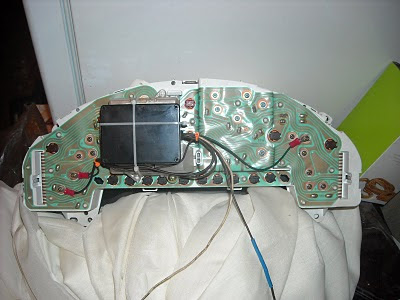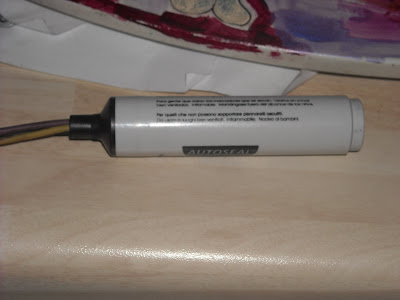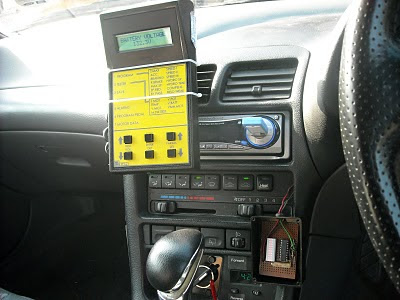137: Friday 23rd April 2010
I have nearly completed 900 miles since 9th March, so far no real problems with the drive. I am still waiting for the LEDs that I ordered so I set about fixing a typical Ford Probe problem. When I unlock from the drivers door, the passenger door does not unlock and the alarm goes off. This suggests that it is unlocking mechanically, but the switch is not detecting the key so it is not operating the central locking. I took off the door pad and sure enough there was the switch hanging down inside the door. I clipped it back on and now the locks work fine. I put the door pad back together and that is a niggly job out the way. I won't need to go to passenger door now every time I get in the car. Of course now I won't keep setting off my alarm when I forget too. I am looking forward to getting my LEDs so I can get the fuel gauge working now.
136: Sunday 18th April 2010
I mounted the fuel gauge circuit on the back of the cluster, but the gauge did not work. I tried all sorts of different configurations and the problem was due to the gauge mode of operation where it measures a low resistance to ground from the fuel sender originally, so the voltages were arbitrary. In order to make this work I needed a PNP power transistor configure as emitter follower from the output of the circuit. Then disaster struck, I was taking the gauge from the cluster and I dropped it and broke the needle shaft. There was no way to repair it, so I needed a new plan.
 ----
----
I thought about just getting another cluster, but decided to use the fascia and mount 10 LEDs around the edge to make it a curved bar graph display. That will look much cooler too and be easy to read. I will have 4 red LEDs at the bottom end, then 3 yellow and 3 green. I went to my local electronics shop and bought an LM3914 bar graph display driver, but they did not have the LEDs I wanted. I have ordered them on-line and now have to wait for them to arrive. I already had an LED bar graph matrix of 10 LEDs in a rectangle mount, so I built the circuit on a prototype board and tested it. That worked o.k. so I then made it up on some strip board and mounted it in the box that I had for the old circuit. I have threaded this through the centre console and calibrated it to show the right number of LEDs for the state of charge. I have a 1000 micro-Farad capacitor on the 120V supply that keeps the voltage when the throttle is pressed, and recharges when the throttle is released. The level does drop off when driving, but it comes back instantly when the throttle is released, so this is just a quirk that I will have to get used to. Anyway the temporary set-up is now in use and working well, so when the LEDs arrive I can work on mounting this all in the cluster. It is difficult to make out the LEDs in the photo, but they are there in the white rectangle in the black box hanging out of the centre console in the photo below. All 10 LEDs are "on"as I had just charged up the batteries and the display on the programmer is reading 132.3 volts. I have temporarily mounted the programmer unit on my Tom-Tom bracket on the air vents as it was getting in the way down by the gear lever. Fortunately it flips up so I can still adjust the volume on my stereo.
 ----
----I thought about just getting another cluster, but decided to use the fascia and mount 10 LEDs around the edge to make it a curved bar graph display. That will look much cooler too and be easy to read. I will have 4 red LEDs at the bottom end, then 3 yellow and 3 green. I went to my local electronics shop and bought an LM3914 bar graph display driver, but they did not have the LEDs I wanted. I have ordered them on-line and now have to wait for them to arrive. I already had an LED bar graph matrix of 10 LEDs in a rectangle mount, so I built the circuit on a prototype board and tested it. That worked o.k. so I then made it up on some strip board and mounted it in the box that I had for the old circuit. I have threaded this through the centre console and calibrated it to show the right number of LEDs for the state of charge. I have a 1000 micro-Farad capacitor on the 120V supply that keeps the voltage when the throttle is pressed, and recharges when the throttle is released. The level does drop off when driving, but it comes back instantly when the throttle is released, so this is just a quirk that I will have to get used to. Anyway the temporary set-up is now in use and working well, so when the LEDs arrive I can work on mounting this all in the cluster. It is difficult to make out the LEDs in the photo, but they are there in the white rectangle in the black box hanging out of the centre console in the photo below. All 10 LEDs are "on"as I had just charged up the batteries and the display on the programmer is reading 132.3 volts. I have temporarily mounted the programmer unit on my Tom-Tom bracket on the air vents as it was getting in the way down by the gear lever. Fortunately it flips up so I can still adjust the volume on my stereo.
135: Sunday 11th April 2010
Thursday I had an interview with Ford News about the Probatron. We chatted about the electric driving experience, had some photos done and then I sent them an email with the features of the car. That was cool. Last week I designed the circuits for the fuel gauge and rev counter conversion to state of charge and ammeter respectively. I then ordered the parts I needed from an electronics supplier. Today I constructed the 2 parts of the circuit for the fuel gauge to state of charge gauge conversion. The first part shown below takes 135v to 115v range and strips off 110v with zener diodes making the result between 25v and 5v. This goes through a potential divider to further reduce the voltage to a signal to drive the LED in an opto coupler. Typically opto couplers are used to separate different voltages, but only for on and off signals. I am using it for a linear signal. I tested it on a prototype board and it works fine. This way the 120v system and the gauge are isolated by the opto coupler. I only had one project box so I designed this circuit carefully so that it fits in a marker pen case. This will make it easy to mount on the throttle linkage bracket and it will be hidden.

 ----
----
The second part of the circuit picks up the signal from the LED in the opto coupler using the photo-transistor inside the opto coupler. This is configured as an emitter follower that feeds a transistor inverting amplifier. This then flips the voltage. The amplifier supply is provided by a 3.6v zener diode and a normal diode making the voltage 3.2v on the supply through a resistor to the collector of the power transistor. The output will measure 3.2v when the input is 113volts. It will measure 2.7v when the input is 116volts and it will measure 0v when the input is between 128 and 135volts. The gauge shows empty when it is supplied with 2.7v and full at 0v. So this will tell me empty at 116v and that is about 20% remaining and that is as low as I would want to go with Lead Acid batteries. The input circuit is adjustable, so when I get Lithium batteries then I can pop the circuit out of the marker pen case, adjust it then pop it back in.

 ----
----The second part of the circuit picks up the signal from the LED in the opto coupler using the photo-transistor inside the opto coupler. This is configured as an emitter follower that feeds a transistor inverting amplifier. This then flips the voltage. The amplifier supply is provided by a 3.6v zener diode and a normal diode making the voltage 3.2v on the supply through a resistor to the collector of the power transistor. The output will measure 3.2v when the input is 113volts. It will measure 2.7v when the input is 116volts and it will measure 0v when the input is between 128 and 135volts. The gauge shows empty when it is supplied with 2.7v and full at 0v. So this will tell me empty at 116v and that is about 20% remaining and that is as low as I would want to go with Lead Acid batteries. The input circuit is adjustable, so when I get Lithium batteries then I can pop the circuit out of the marker pen case, adjust it then pop it back in.
Tomorrow I hope to get the circuits fitted to the car along with a 1000 micro Farad capacitor to the throttle switch so the the capacitor holds the voltage that is present when the throttle is released only. So this is off-load and should be fairly stable. The gauge itself takes a couple of minutes to stabilize when the readings change anyway. I will monitor the gauge with the zapi programmer tester function showing the instantaneous voltage so I can check it when I stop and get an idea of how it reads for the different voltages. The gauge behaviour wasn't exactly linear. You may feel that the last bit of fuel goes quicker, but it doesn't, just the gauge goes down quicker due to the non-linearity of the gauge. It is not drastic and I am confident the gauge will give me a good indication. At the same time I have not had to add another gauge, but using a redundant one instead. This keeps it all neat looking. As an added bonus, when the gauge gets down a fair way, then the fuel low warning light comes on too, how's that! All the components I have bought for both gauges have come to just over £20 and that is less than half the price of an ugly add-on gauge and not including some kind of pod to put it into as well. I like to have my instruments look like they have always been in the car and not look like a dodgy add-on. I've seen quite a few examples of this on-line. I am not going to label anybody specifically.
Subscribe to:
Posts (Atom)


